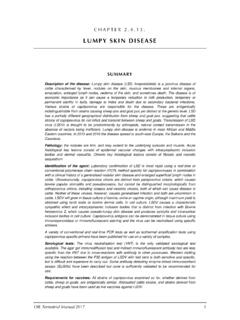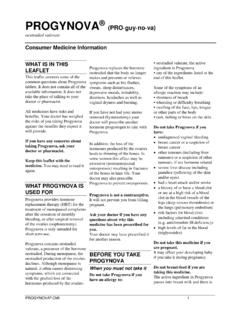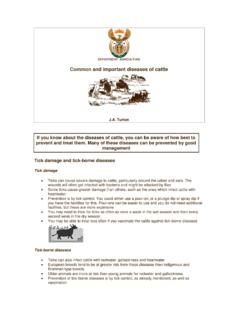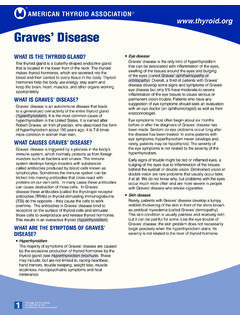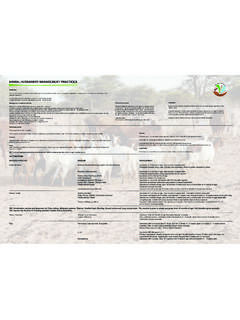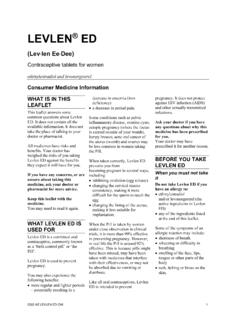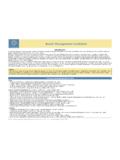Transcription of Common Diseases of Farm Animals - KASHVET
1 Common Diseases of farm Animals , by R. A. Craig Title: Common Diseases of farm Animals Author: R. A. Craig, D. V. M. Release Date: July, 2005 [EBook #8502] Edition: 10 Language: English Character set encoding: ASCII Visit: Common Diseases OF farm Animals By R. A. Craig, [Illustration: Frontispiece--INSANITARY DAIRY STABLE AND YARDS. disease AND FINANCIAL LOSS ARE TO BE EXPECTED WHEN farm Animals ARE KEPT IN FILTHY, INSANITARY QUARTERS] PREFACE In preparing the material for this book, the author has endeavored to arrange and discuss the subject matter in a way to be of the greatest service and help to the agricultural student and stockman, and place at their disposal a text and reference book. The general discussions at the beginning of the different sections and chapters, and the discussions of the different Diseases are naturally brief.
2 An effort has been made to conveniently arrange the topics for both practical and class-room work. The chapters have been grouped under the necessary heads, with review questions at the end of each chapter, and the book divided into seven parts. The chapters on Diseases of the locomotory organs, the teeth, surgical Diseases and castration, although not commonly discussed in books of this class, the writer believes will be of value for reference and instructional work. When used as a text-book, it will be well for the instructor to supplement the text with class-room discussions. The writer has given special emphasis to the cause and prevention of disease , and not so much to the medicinal treatment. Stockmen are not expected to practise the medicinal treatment, but rather the preventive treatment of disease . For this reason it is not deemed advisable to give a large number of formulas for the preparation of medicinal mixtures to be used for the treatment of disease , but such treatment is suggested in the most necessary cases.
3 R. A. CRAIG. PURDUE UNIVERSITY, LaFayette, Ind. August, 1915. CONTENTS PART I. GENERAL DISCUSSION OF disease II. DIAGNOSIS AND SYMPTOMS OF disease III. TREATMENT PART OR GENERAL Diseases . IV. Diseases OF THE DIGESTIVE SYSTEM V. Diseases OF THE LIVER VI. Diseases OF THE URINARY ORGANS VII. Diseases OF THE GENERATIVE ORGANS VIII. Diseases OF THE RESPIRATORY APPARATUS IX. Diseases OF THE CIRCULATORY ORGANS X. Diseases OF THE NERVOUS SYSTEM XI. Diseases OF THE SKIN XII. Diseases OF THE EYE XIII. GENERAL Diseases OF THE LOCOMOTORY APPARATUS XIV. STRUCTURE OF THE LIMBS OF THE HORSE XV. UNSOUNDNESSES AND BLEMISHES XVI. Diseases OF THE FORE-LIMB XVII. Diseases OF THE FOOT XVIII. Diseases OF THE HIND LIMB PART TEETH. XIX. DETERMINING THE AGE OF Animals XX. IRREGULARITIES OF THE TEETH PART Diseases .
4 XXI. INFLAMMATION AND WOUNDS XXII. FRACTURES AND HARNESS INJURIES XXIII. Common SURGICAL OPERATIONS PART Diseases . XXIV. PARASITIC INSECTS AND MITES XXV. animal PARASITES PART Diseases . XXVI. HOG-CHOLERA XXVII. TUBERCULOSIS XXVIII. INFECTIOUS Diseases Common TO THE DIFFERENT SPECIES OF DOMESTIC Animals XXIX. INFECTIOUS Diseases OF THE HORSE XXX. INFECTIOUS Diseases OF CATTLE XXXI. INFECTIOUS Diseases OF POULTRY REFERENCE BOOKS ILLUSTRATIONS FIG. (Frontispiece) Insanitary dairy stable and yards. 1. Side and posterior view of bull showing conformation favorable to the development of disease . 2. Insanitary yards. 3. Showing where pulse of horse is taken. 4. Auscultation of the lungs. 5. Fever thermometer. 6. Dose syringe. 7. Hypodermic syringes. 8. Photograph of model of horse's stomach. 9.
5 Photograph of model of stomach of ruminant. 10. Oesophageal groove. 11. Dilated stomach of horse. 12. Rupture of stomach of horse. 13. Showing the point where the wall of flank and rumen are punctured with trocar and cannula in "bloat". 14. Photograph of model of digestive tract of horse. 15. Photograph of model of digestive tract of ruminant. 16. A yearling colt that died of aneurism colic. 17. Photograph of model of udder of cow. 18. Photograph of model of uterus of cow containing foetus. 19. Placenta of cow. 20. A case of milk-fever. 21. Milk-fever apparatus. 22. A case of catarrhal cold. 23. Photograph of model of horse's heart. 24. Elephantiasis in horse. 25. Photograph of model of horse's brain. 26. Unilateral facial paralysis. 27. Bilateral facial paralysis. 28. Skeleton of horse. 29. Photograph of model of stifle joint. 30.
6 Atrophy of the muscles of the thigh. 31. Shoulder lameness. 32. Shoe-boil. 33. Sprung knees. 34. Splints. 35. Bones of digit. 36. Photograph of a model of the foot. 37. Foot showing neglect in trimming wall. 38. A very large side bone. 39. A case of navicular disease . 40. An improperly shod foot. 41. Toe-cracks. 42. Quarter-crack caused by barb-wire cut. 43. Changes occurring in chronic laminitis. 44. Atrophy of the muscles of the quarter. 45. String-halt. 46. A large bone spavin. 47. Normal cannon bone and cannon bone showing bony enlargement. 48. Bog spavins. 49. Thorough pin. 50. Curbs. 51. Head of young horse showing position and size of teeth. 52. Longitudinal section of incisor tooth. 53. Cross-section of head of young horse, showing replacement of molar tooth. 54. Transverse section of incisor tooth 55. Transverse sections of incisor tooth showing changes at different ages.
7 56. Teeth showing uneven wear occurring in old horses. 57. Fistula of jaw. 58. A large hock caused by a punctured wound of the joint. 59. A large inflammatory growth following injury. 60. Fistula of the withers. 61. Shoulder abscess caused by loose-fitting harness. 62. A piece of the wall of the horse's stomach showing bot-fly larvae attached. 63. Biting louse. 64. Sucking louse. 65. Nits attached to hair. 66. Sheep-tick. 67. Sheep scab mite. 68. Sheep scab. 69. A severe case of mange. 70. Liver flukes. 71. Tapeworm larvae in liver. 72. Tapeworms. 73. Tapeworm larvae in the peritoneum. 74. Thorn-headed worms. 75. Large round-worm in intestine of hog. 76. Lamb affected with stomach worm disease . 77. Whip-worms attached to wall of intestine. 78. Pin-worms in intestine. 79. A hog yard where disease -producing germs may be carried over from year to year.
8 80. Carcass of a cholera hog. 81. Kidneys from hog that died of acute hog-cholera. 82. Lungs from hog that died of acute hog-cholera. 83. A piece of intestine showing intestinal ulcers. 84. Cleaning up a hog lot. 85. Hyperimmune hogs used for the production of anti-hog-cholera serum. 86. Preparing the hog for vaccination. 87. Vaccinating a hog. 88. Koch's _Bacillus tuberculosis_. 89. A tubercular cow. 90. Tubercular spleens. 91. The carcass of a tubercular cow. 92. A section of the chest wall of a tubercular cow. 93. A very large tubercular gland. 94. A tubercular gland that is split open. 95. Caul showing tuberculosis. 96. Foot of hog showing tuberculosis of joint. 97. _Staphylococcus pyogenes_. 98. _Streptococcus pyogenes_. 99. Bacillus of malignant oedema, showing spores. 100. Bacillus of malignant oedema. 101. _Bacillus bovisepticus_.
9 102. A yearling steer affected with septicaemia haemorrhagica. 103. _Bacillus anthracis_. 104. _Bacillus necrophorus_. 105. Negri bodies in nerve-tissue. 106. A cow affected with foot-and-mouth disease . 107. Slaughtering a herd of cattle affected with foot-and-mouth disease . 108. Disinfecting boots and coats before leaving a farm where cattle have been inspected for foot-and-mouth disease . 109. Cleaning up and disinfecting premises. 110. _Bacillus tetani_. 111. Head of horse affected with tetanus. 112. A subacute case of tetanus. 113. Streptococcus of strangles. 114. _Bacillus mallei_. 115. Nasal septum showing nodules and ulcers. 116. _Streptococcus pyogenes equi_. 117. A case of "lumpy jaw". 118. The ray fungus. 119. Bacillus of emphysematous anthrax. 120. Cattle tick (male). 121. Cattle tick (female). 122. Blood-cells with _Piroplasma bigeminum_ in them.
10 123. _Bacillus avisepticus_. Visit: PART CHAPTER I GENERAL DISCUSSION OF disease disease is the general term for any deviation from the normal or healthy condition of the body. The morbid processes that result in either slight or marked modifications of the normal condition are recognized by the injurious changes in the structure or function of the organ, or group of body organs involved. The increase in the secretion of urine noticeable in horses in the late fall and winter is caused by the cool weather and the decrease in the perspiration. If, however, the increase in the quantity of urine secreted occurs independently of any normal cause and is accompanied by an unthrifty and weakened condition of the animal , it would then characterize disease . Tissues may undergo changes in order to adapt themselves to different environments, or as a means of protecting themselves against injuries.


